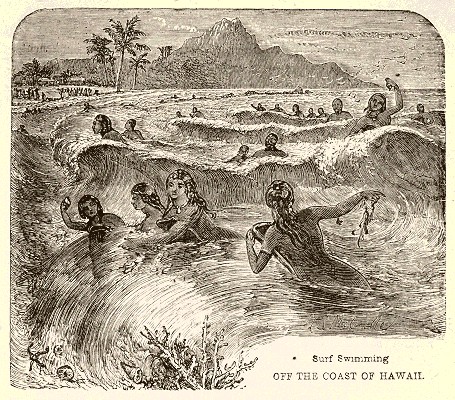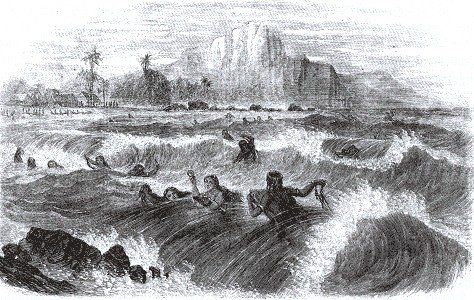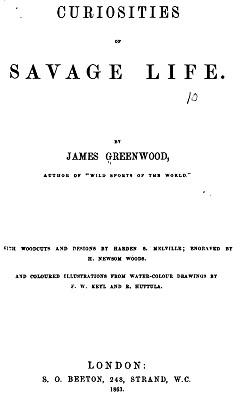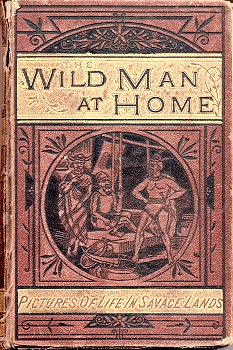 |
surfresearch.com.au
greenwood : hawaii and tahiti, 1863 |
| home | catalogue | history | references | appendix |
|
Hathi Trust Digital
Library
http://hdl.handle.net/2027/uc1.b3426244
The illustration
at the beginning of the chapter is titled Surf Swimming off the Coast
of Hawaii, all the illustrations accredited on the title page
as
"Woodcut and design
by Harden S. Melville.
Engraved by Newsom
Woods."
Melville served
as a draughtsman on several expeditions by the English navy in the western
Pacific between 1841 and 1845, and produced a signficant amount of work
before returning to London by 1847.
It is unknown
if Melville visited Hawai'i, but there is a possibility that he crossed
the Pacific on his return to England.
The illustration
bears a remarkable similarity to Surf swimming at Hawaii, Sandwich Islands,
printed in Leslie's Illustrated Weely in 1866, see Notes,
below.

Faahee, or surf-swimming, is
another favourite pastime with these people.
According to Ellis, "individuals of
all ranks and ages and both sexes follow this sport with great avidity.
They usually selected the openings
in the reefs or entrances of some of the bays, where the long heavy billows
rolled in unbroken majesty upon the reef or the shore.
They used a small board, which they
called papa faahee- swam from the beach to a considerable
distance, sometimes nearly a mile-
watched the swell of the wave, and when it reached them, resting their
bosoms on the short, flat-pointed board, they mounted on its summit, and
amid the foam and spray rode on the crest of the wave to the shore; sometimes
they halted among the coral rocks, over which the waves broke in splendid
confusion.
When they approached the shore, they
slid off the board, which they grasped with the hand, and either fell behind
the wave or plunged towards the deep and allowed it to pass over their
heads.
Sometimes they were thrown with violence
upon the beach, or among the rocks on the edges of the reef.
So much at home, however, do they feel
in the water, that it is seldom any accident occurs.
" I have often seen along the border
of the reef forming the boundary line to the harbour of Fare in Huahine,
from fifty to a hundred persons of all ages, sporting like so many porpoises
in the surf that has been rolling with foam and violence towards the land;
sometimes mounted on the top of the wave, and almost enveloped in spray,
at other times plunging beneath the mass of water that has swept like mountains
over them, cheering and animating each other; and by the noise and shouting
they made rendering the roar of the sea and the dashing of the surf comparatively
imperceptible."
The illustration bears a remarkable similarity to the unaccredited image Surf swimming at Hawaii, Sandwich Islands, printed in Leslie's Illustrated Weely, New York, 7 April 1866, page 37.
James Greenwood (1832 - 1929)
Greenwood was a British social explorer,
journalist and writer.
He began his career on the Pall Mall
Gazette where he wrote several articles on social issues, themes continued
when he moved to
Daily Telegraph.
Although primarily a journalist, novelist,
miscellaneous writer, and author of juvenile fiction, Greenwood authored
several works on savages.
It is unlikely that
Greenwood travelled to the South Seas, either to Tahiti or Hawaii, in the
1800s.
Harden S. Melville
(1824-1894)
A son of the London
engraver, lithographer and watercolour painter Henry Melville (1826-41),
Harden quickly established a reputation as an artist and between 1837 and
1841 had had three paintings hung in the Royal Academy’s summer shows.
In 1841 he accepted
the position of draughtsman on board HMS Fly, a decision he later
recalled as inspired by reading Captain Cook’s Voyages as a boy, to conducted
the first official hydrographic survey of the north-east coast of Australia.
A considerable body
of his Australian and Pacific work is known.
Original shipboard
sketches of Pacific subjects are included in John Sweatman 's journal of
a surveying voyage in H.M.S. Bramble, 1842-1847 (Mitchell Library,
State Library of New South Wales, Sydney)
Bush Scene, Swan
River, W.A. is in the National Library.
Following his return
to London in 1847, Melville continued his career as an illustrator and
painter.
He provided nineteen
drawings and two maps for Joseph Beete Jukes’s official Narrative of
the Surveying Voyage of H.M.S. Fly (2 vols, London, 1847)
A collection of
twenty-five tinted lithographs (hand-coloured in the expensive edition),
each with a leaf of descriptive notes, titled Sketches in Australia
and the Adjacent Islands (London) was published in 1849.
Included are views
of Port Essington (Northern Territory), the Queensland and New South Wales
coasts, Port Phillip, Van Diemen’s Land, the Swan River (WA), New Guinea,
Timor, Java and other places visited.
In addition to Surf
Swimming off the Coast of Hawaii in James Green
wood’s Curiosities
of Savage Life (London, 1863), Harden supplied five illustrations
of Australian Aborigines and their weapons.
The autobiographical
The
Adventures of a Griffin on a Voyage of Discovery (London 1867) contains
a frontispiece and twenty-nine other illustrations drawn on the wood by
Melville from his original voyage sketches, then cut by H.N. Woods.
- Design and Art
Australia Online
http://www.daao.org.au/bio/harden-sidney-melville/biography/?
It is unknown if Melville visited Hawai'i, but there is a possibility that he crossed the Pacific on his return to England.
Leslie's Illustrated Weely (1866): Surf swimming at Hawaii, Sandwich Islands.
As stated in the
introduction, Melville's illustration bears a remarkable similarity to
Surf
swimming at Hawaii, Sandwich Islands, printed in Leslie's Illustrated
Weely in 1866.
The illustrations
are reproduced below:

Melville, 1863. |

Anonymous:
|
Melville was a successful
artist and is known to have, at least, traveled to the west Pacific in
the 1840s.
The significant
differences are in the coral and sea-life in the bottom right corner and
the mountain profile in the background.
In the 1866 illustration,
the bottom right corner has some large rocks and the mountain formation
is, perhaps, less Polynesian.
Furthermore, on close
inspection it is difficult to confirm that any of the participants is demonstrably
wave riding, although it must be said that it is poorly represented in
most of the early illustrations.
In both illustrations,
the swimmers, some with small boards, appear to be harvesting shellfish
and seaweed.
 |
Curiosities of Savage Life. S.O. Beeton, London, 1863. Hathi Trust Digital
Library
|
 |
The Wild Man at Home: or, Pictures of Life in Savage Lands Ward, Lock, and Co., Warwick House, Dorset Buildings, Salsbury Square, E.C. 1885. |
ALEXANDER HUME FORD:.Riding
Breakers
Evening Bulletin,
Honolulu, July 17, 1908, page 7.
"As a boy I used
to sit in school idling away my time building air castles over the picture
in my geography book of Hawaiian men
and women (in impossible
attitudes) who, standing on the tiniest of boards, stood poised upon the
crest of monster rollers.
I longed for Hawaii
and sighed to read the brief statement that only native Hawaiians of all
the people in the world ever
accomplished the
art of standing on the waves."

| home | catalogue | history | references | appendix |
The Adventures
of a Griffin on a Voyage of Discovery (London 1867)
I92
The swimming powers
of the Darnley Islanders, it would
appear, could only
be excelled, if equalled, by the fish them-
selves. Oftentimes
when alongside the ship bartering their
tortoiseshell (of
which Jack managed to get hold of a goodly
store), a piece
of iron falling overboard was arrested before
it had sunk far
down. They seemed intimate with the sharks,
and apparently entertained
little fear of them.